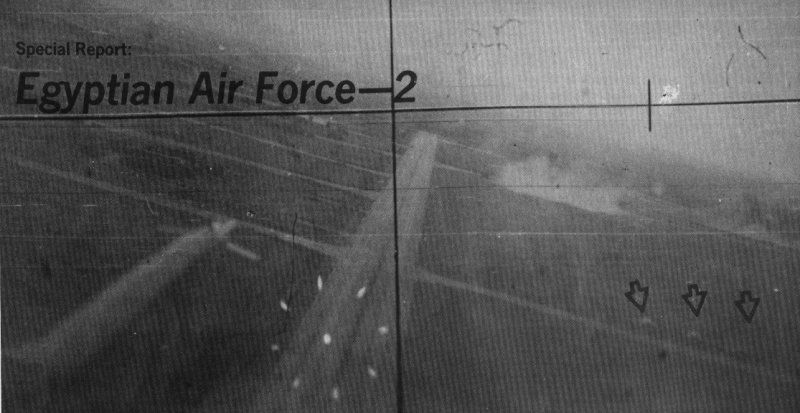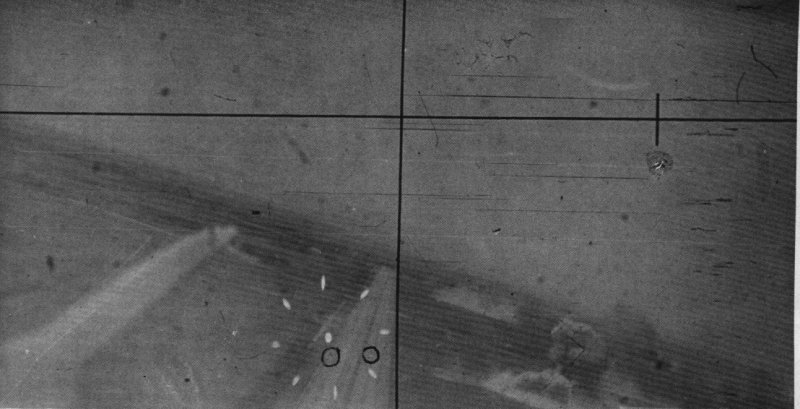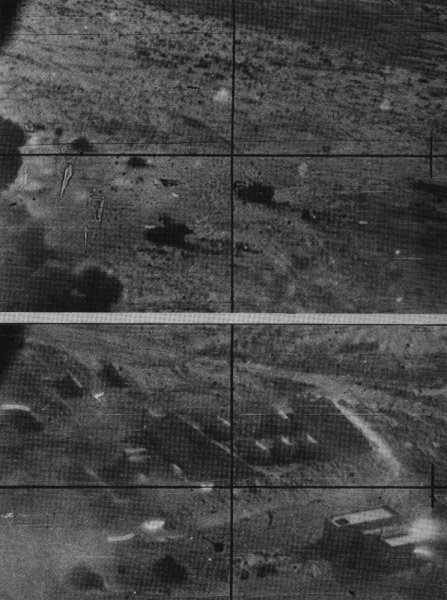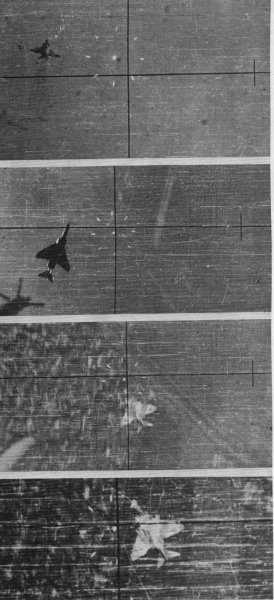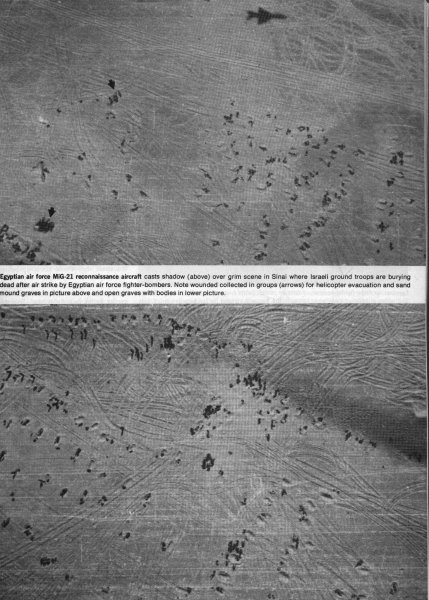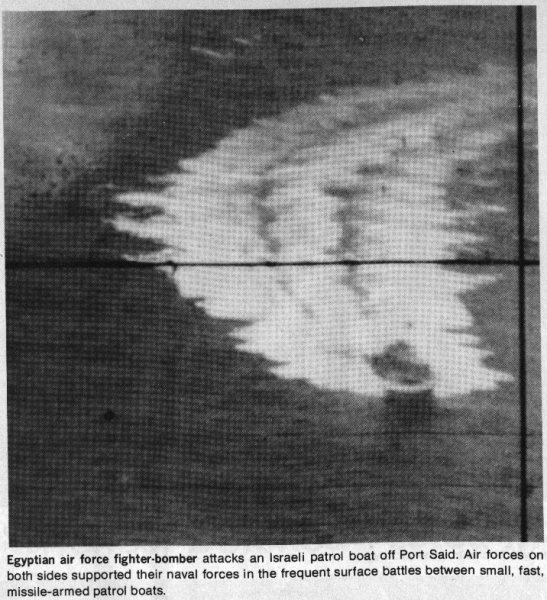Egyptian Air Force - 2
Egyptian air force MiG-21 (note air speed boom lower left) makes a strafing attack on the Israeli air field at Ras Nasrani at the extreme southern end of Sinai near Sharm al Sheik in photos above. Attack was made as part of opening Egyptian offensive on afternoon of Oct. 6, 1973. Note three Israeli air force Mirage fighters parked (arrows along taxiway in the open (above). MiG-21 gun camera sight centers on two Mirages scrambling down runway for takeoff (circles) while bombs from other EAF strike planes explode on airfield.
Sukhoi Su-7 fighter-bombers attack an Israeli armored force logistics park in the Sinai early in the October, 1973, War. Note fuel tank trailers parked in revetments and armored vehicles on the move under attack.
Egyptian air force MiG-21 gun camera film shows attacks on Israeli air force F-4 Phantoms during air battles over Nile Delta. MiG-21 gun sight is shown in circle of blips with dot in center. Bomb-carrying Israeli Phantom aircraft were primary target of MiG-21 interceptors during attacks on Nile Delta airfields and Port Said.
Offense, Defense Tested in 1973 War
By Robert Hotx
Cairo-Egyptian air force mounted one major offensive battle in the October, 1973, War and then fought a series of defensive battles to parry the offensive thrusts of the Israeli air force.
The major offensive was launched in the afternoon of Oct. 6, 1973, against a broad spectrum of Israeli defensive positions in Sinai and began the Egyptian assault that crossed the Suez Canal and established a major bridgehead on the eastern bank, which the Egyptian army still occupies. It consisted of 220 strike aircraft, includingMiG-2ls, Sukhoi Su-7s, MIG-17s and Hawker Hunters, and l00 Mil Mi-8 assault helicopters.
The aircraft strikes were targeted on a pre-planned series of Israeli installations in Sinai from which support could be given to the Bar-Lev line fortifications. These included airfields at Bit Cifgafa, El Arish, Ras Nasrani and Bir Tamada, command posts, 'l75-mm. long-range artillery positions, Hawk missile batteries, electronic countermeasures (ECM) centers and armored force parks and logistics centers. All of these targets had been constructed in full-scale mock ups in the Libyan desert, and each attack force trained specifically against its assigned target for weeks in advance of the Yom Kippur D-day.
These strikes were launched at 2 p.m.Oct. 6 and were made without any air opposition from the Israeli air force. Defensive fire was encountered from Hawk missile batteries and scattered antiaircraft gun positions, and Egyptian losses were light.
An example of how the lessons of the 1967 war were applied in reverse in 1973was the Egyptians' development of a special rocket-propelled bomb for deep-cratering runways. The Israelis originally used this type of weapon, known as the "concrete dibber," to blast Egyptian runways in their initial strikes that immobilised the Egyptian air force on the grounding 1967. On Yom Kippur, 1973, the Egyptian air force delivered its own rocket-propelled "dibbers" on the runways of all the forward Israeli airfields in Sinai. It also attacked logistics areas and scattered delayed-action bombs to inhibit movement of repair personnel. Egyptian officers note that the Sinai airfields stayed inoperative for 48 hr. after the initial strikes, They also believe they knocked out the main Israeli command post for the Sinai front, because command and control communications suddenly shifted 20 another installation at El Arish, and the Israeli sector commander, Maj. Gen. Abraham Mendler, was killed.
They also claim the destruction of the main ground-based electronic countermeasures station in Sinai and several Hawk batteries. As further evidence of the complete surprise achieved by these air strikes, Egyptian air force commanders cite a complete lack of Israeli radar and communications jamming.
At last light an Oct. 6, a force of 100 Ni-8 armed helicopters loaded with 18-man commando teams was launched deep into Sinai to attack the Israeli-occupied oil fields and to disrupt the flow of Israeli reinforcements for the Canalfront. We talked with one Egyptian helicopter pilot who had been decorated for bravery in this phase of the operations for making three penetrations of Sinai with his Mi-8. The first two carried commandos who set fire to oil wells and the third set up a position to interdict one of the main roads by which Israeli reserve armor had to travel to reach the Bar-Lev line.
The helicopter crew, supported by commandos armed with Sagger and RPG-7 anti-tank weapons, attacked an Israeli armored column strung out in single file along the hard road with sand on one side and marshland on the other. making it impossible to maneuver. They knocked out the lead tanks as they appeared, blocking the road and fin a114forcing the armor to retreat in search of another route to the front. The Mi-8 was equipped with eight external bomb racks and rocket launcher rails. The pilot used the helicopter's maneuverability to make direct attacks on the tank column in support of the deployed commandos.
Egyptian air force commanders believe the helicopter-commando assault team played a major role in disrupting the rear of the Israeli Bar-Lev line during the time that major counterattacks should have been organised. They also diverted a portion of the Israeli reserve forces to widely scattered areas of Sinai to root them out. The Egyptian commandos took heavy losses, but some of them returned and some units fought for as long as a week in the Sharm el Sheik area before surrendering.
On the second day of the war, the Israeli air force mounted a major attack on the Egyptian air force bases in the Nile delta. The Israeli McDonnell DouglasPhantoms, Skyhawks and Dassault-Breguet Mirages came in from the North at extremely low level over the Mediterranean Sea. They attacked in seven waves and penetrated to bomb a number of Egyptian air fields and surface-to-air missile (SAM) sites. But the Egyptian air defence forces said they got good warning from their visual observer corps posted along the seacoast and were able to put up 50 MiG-21 interceptors to begin the massive air battle over the coastline. The MiG-21 formations attacked the Phantoms first to get them to jettison their bombs. The Israelis made a determined penetration, and the air battle swirled through the air defence force missile belt to the airfield target areas.
Egyptian air defence force commanders say that in these air battles over the Nile Delta they did not destroy a single Egyptian aircraft with missile fire while extracting a high toll of Phantoms and Skyhawks. They admit that in other battles over the Suez Canal missile belt they did hit friendly aircraft with SAM missiles despite the use of an identification system to distinguish friend from foe (IFF). Both air force and air defence force commanders confirmed that, while it was an operational goal to use the MiG-21 as the first force to engage enemy aircraft at maximum range, it also was tactical doctrine for the interceptors to fight within the missile belt and continue harrying attacking forces all the way to their targets. They agreed that losses from friendly missiles were so relatively small that the tactics of using both interceptors and missiles in the same airspace was operationally sound and militarily effective against the offensive formations .
The Oct. 7 sweep against the Nil Delta airfields was the biggest Israeli air force effort against these targets. Smaller attacks were continued on the 8th and 9th acid then broken off completely. The main Israeli air effort shifted to the Canal zone where it concentrated on attacking the many bridges and ferry operations across the Suez. These attacks brought the Israeli aircraft within range of both the Canal missile belt and the Egyptian interceptors. The Egyptian airforce also continued its strikes in Sinai against Israeli armor and supply columns and dumps. All of the aerial battles in the Canal area started at low level because the interceptors, both MiG-2ls and Mirages, were after the fighter-bombers attacking at minimum altitude.
After it gave up major air sweeps against the Nile Delta airfields, the Israeli air force launched a major campaign against Port Said.
Egyptian commanders are not sure exactly what the Israeli goal was in its sustained and dogged stir attacks on Port Said, Some think the Israeli bombing was a prelude to an airborne assault by paratroops and capture of the city to open a sea-borne supply route to support operations on the northeast bank of the Suez
Canal. Some think it was an attempt to flank the main Canal missile belt and eventually open a path to attack it from the rear. In any event all agree that Port Said is a key strategic as well as symbolic point to Egyptians. Most of the historic invasions of Egypt right up to the 1956 Angle-French attack have come through Port Said, and the feeling is that if Port Said falls Egypt is really in danger.
Whatever the Israeli motives, the air campaign never reached the point where the defences were permanently suppressed and whatever was planned for phase two never was able to materialise. The air battles stretched over a period of five days, and each day the Israeli air force was able to beat down the defences to the point where its commanders thought they were destroyed. SAM batteries were smashed, and the town itself was pounded into ruins, particularly the shipyards and other facilities essential to the operation of the Suez Canal. But each night the Egyptian air defence forces rebuilt their shattered system and were in action in the morning against the initial Israeli attacks. The Egyptians claim the Israeli air force lost 28 aircraft in the battles over Port Said to interceptors, missiles and guns.
The final air battles were fought over the Israeli armored breakthrough onto the west bank of the Canal at Deversoir. These armored forces also captured a number of SA-3 and Aak sites in the Canal missile belt that temporarily gave the Israeli air force a gap through which it could provide close support for the marauding tanks against Egyptian counterattacks.
The Egyptian air force was sucked into this maw in a final struggle to stop the Israeli air force attacks and to attack the spreading Israeli armored columns racing south toward Suez, Both sides apparently threw everything they had left into this struggle, The Egyptians, whittled down by two weeks of combat losses, even committed their L-29 Delfin jet trainer force to attacks on the Israeli armor. The Czech-built L-29s also are used for initial weapon delivery training at the Egyptian air force training center at Bilbeis and are equipped to deliver rockets and bombs. Several Delfins were lost in this effort, but the air force commanders believe they performed well in the emergency, There is a similarity between this desperate use of a trainer force and the way the Israelis committed their Fouga Magister training airplanes with their instructors on the second day of the bitter tank battle in the Mitla Pass in June, 1967.
There was another series of swirling, enlarging dogfights over the expanding Deversoir pocket in the closing week of the war. The fights generally started on the deck as interceptors bounced attacking fighter-bombers acid were in turn bounced by enemy interceptors who were also hit by arriving reinforcements. It was in these fights that the Egyptian air force pilots felt strongly the presence of a new type of pilot flying U. S.-delivered Phantoms (AW&ST June 30, P. 12).
Another example of how the Egyptian air force applied the lessons it learned from the Israelis during the war of attrition was told by a 32-year-old deputy MiG-21 regiment commander who has been flying since he was 15.
"During the war of attrition, the Israeli air force had a favourite ambush tactic," he told AVIATION WEEK & SPACE TECHNOLOGY. “They would penetrate with two aircraft at medium altitude where they would be quickly picked up by radar, We would scramble four or eight to attack them. But they had another dozen fighters trailing at extremely low altitude below radar coverage. As we climbed to the attack they would zoom up behind and surprise us. My regiment lost MiGs to this ambush tactic three times. But we learned the lesson and practiced the same tactics. In the final fights over Deversoir, we ambushed some Mirages the same way, and my own 'finger four' [formation] shot down four Mirages with the loss of one MiG."
The Egyptian air force may not believe it won the air war of October, 1973, but it does believe that it was able to stay in the air and slug it out with the best the Israeli air force had to offer, that it denied the enemy the freedom of operation over Egyptian forces to which it had become accustomed, that it carried the attack to enemy ground forces in crucial periods and that it has knocked considerable chrome off the Israeli air force's halo of invincibility .
(This is the second of a two-part series. The first was carried June 30, p. 12,)
Pilot Rescue
Ceiro--Egyptian air defence commaners are puzzled by an episode that occurred late in the October, 1973, War when an Israeli Phantom was shot down in Sinai and the pilot ejected and parachuted safely into no-man's land between the two armies.
The Egyptians routinely sent a jeep and two soldiers to pick up the pilot and were driving back toward their lines when an Israeli helicopter appeared. It disgorged a commando team who captured the Egyptians, spirited the pilot into an armored personnel carrier and sped off. "They never made that much of an effort for any other pilot during the whole war," an Egyptian commander noted. "it must have been very important to them. Could it have been one of their American pilots?"
C-97 Shot Down
Caito--Egyptian air defence force concealed its newly developed capabilities until the outbreak of war on Oct. 6, 1973, despite constant Israeli air force 'robes to test them. Sole exception was the shooting down of an israeli air force Booing C-97, equipped as an electronic intelligence snooper, during regular atternoon patrol along the Suez Canal over Israeli-occupied Sinai. The flint aircraft was shot down by surface-to-air SA-2 missiles at a range of 17 mi. inside Sinai on Sept. t 7, 1971. Israel said it was an unarmed transport.
// Прислал Вячеслав «gals» Михалин
Создано 11.01.2025
Связь с владельцами и администрацией сайта: anonisimov@gmail.com, rwasp1957@yandex.ru и admin@balancer.ru.
